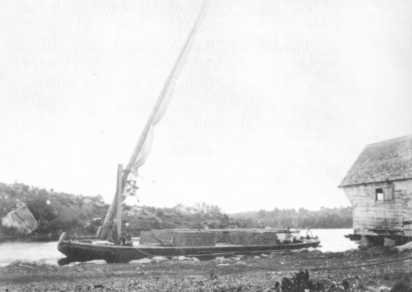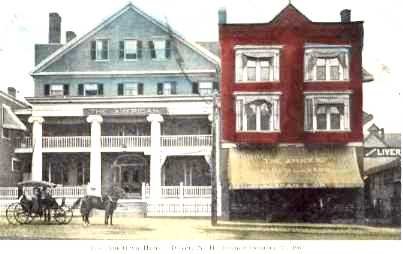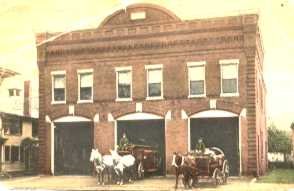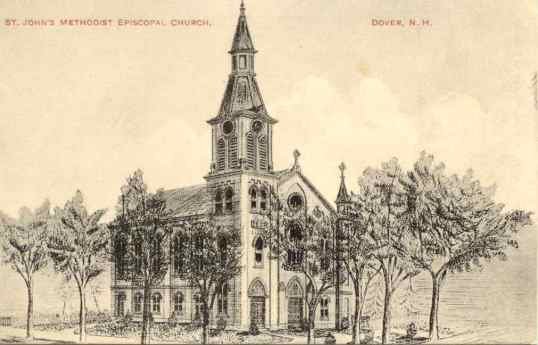Disclaimer
The Dover Public Library website offers public access to a wide range of information, including historical materials that are products of their particular times, and may contain values, language or stereotypes that would now be deemed insensitive, inappropriate or factually inaccurate. However, these records reflect the shared attitudes and values of the community from which they were collected and thus constitute an important social record.
The materials contained in the collection do not represent the opinions of the City of Dover, or the Dover Public Library.
1983 Heritage Walking Tour
Heritage Walking Tour Booklet June 1983 by the Dover Heritage Group, Dover, NH, c. 1983.
In 1978, a group called Dover Tomorrow formed to promote the growth and prosperity of Dover. A subcommittee was tasked with promoting “appreciation of Dover’s heritage”. The Lively City Committee created the first Heritage Walk the next year. It was so popular that new tours were created every year, and held through 2007. By 1982, Dover’s historical society, the Northam Colonists, had taken over the research and creation of the Heritage Walking Tour Booklets. The information on the page below is a transcription of the original Heritage Walking Tour Booklet. The Library has a complete set of the Heritage Walking Tours if you would like to see the original booklets.
The 5th Annual Heritage Walk this year centers on the neighborhood bordered by Main Street, Portland Street, and Broadway. From the earliest days of its settlement, this area was a thriving commercial district,closely tied to boat traffic and businesses on the Cocheco River.
In the 18th century, most of the land north of the Cocheco River was undeveloped, but some structures did exist by the latter part of the century. One of the earliest was Michael Reade’s house (1785), still standing at 43 Main St. Reade was an Irish immigrant who came to Dover in the 1770’s and emerged as a land speculator and merchant. There was also a cooper’s shop on Main, eventually the site of Nathaniel Ela’s famous tavern (1800). Merchant Joshua Hartford built a small store that sold East and West Indian goods across from Reade’s house, and Col. Stephen Evans erected his home near the present brick building on School and Main. Evans was a shipbuilder and a merchant who dealt in West Indian goods. Further north, the Waldron family owned several barns, and even further north were two other houses near present – day New York and Ham Streets. As early as the first decades of the 18th century, most of the land north of the Cocheco was owned by the heirs of Richard Waldron, including the Waldron burying and the grist and saw mills at the falls.
By the 1790’s, the town began to layout roads in the area which served to attract merchants to “The Landing”. The Waldron heirs and the town sold lots to individuals who in turn began building houses and stores. By the early 1800’s it was a bustling place. Dover merchants at “The Landing” purchased goods from ships and then sold them as far away as Lake Winnipesauke. Often, oxen teams would be lining Main Street waiting to purchase goods from various merchants or to sell their own goods, such as lumber. On the river itself, gundalows and schooners were used to haul freight, especially to and from ships anchored at Portsmouth. Gundalows were a common sight on the river, and the business community on “The Landing” was clearly reliant upon them. From the early 1800’s to the 1840’s, there were as many as ten gundalows in constant use on the Cocheco.

In 1815, a series of brick stores were constructed along “The Landing” (since torn down) by Joseph Smith. Smith also built his brick house on Portland Street in 1825, after he had amassed a sizeable income transporting goods to and from the hinterland. The Smith house was so imposing that it dominated the Portland Street area. But it was not the only brick structure in the neighborhood. The John Burns house sat in the middle of what is now Portland Avenue, across from St. John’s. Like Michael Reade, Burns was an Irish immigrant. Burns, a skilled weaver, was put in charge of the weaving room in the no. 2 mill and earned enough money to branch out into more lucrative mercantile endeavors. Burns built his home in 1825 also.
Another brick building that was erected in the 1820’s was the grade school on School Street (the foundation is all that remains). In 1810 a single-story, 35’x40’ wooden structure was built that seemed to reflect the rapid and often frantic building activity in the area at this time; the floors sloped and the seven rows of unfinished pine benches went unpainted. It was known as the Landing School and lasted until 1828 when town officials decided to put up a brick structure. The new school, built in that year, became known, by the mid-19th century, as the Sherman School, in honor of its first master, Enoch Sherman. Unlike the old Landing school, the Sherman School had two stories, with the upper floor reserved for advanced classes. The School was in use till 1938, when a hurricane damaged it beyond repair.

One if the most noteworthy brick structures built in this period was the Sawyer (Platt) Building. The lot was sold to Hosea Sawyer in 1822 by some Waldron heirs, and by 1825 the construction of the building was completed. Sawyer sold imported English and West Indian goods, and soon rented space to people such as John Parker Hale, attorney (and eventual Free Soil Party candidate for President of the U.S.), George Kittredge, MD., and others. That same year, the junction of Portland and Main was dubbed Lafayette Square in honor of the famous Revolutionary War general who aided the cause of American Independence.
While the mercantile activity gave the area a bustling quality, it was the Cocheco Manufacturing Company that transformed the entire Heritage Walking area. The mills altered the area both in residential patterns and in social complexion, and they guaranteed the increased settlement, fast-placed real estate speculation, and the energetic construction of private dwellings.
The neighborhood of the Heritage Walk area was, from the beginning, socially and economically mixed; one of the wealthiest and most prominent citizens in Dover, Daniel Durrel, lived here, as well as a sizable laboring population. Mechanic and School Streets illustrate this trend. Both streets were laid out about the same time (before the war of 1812), and by the late 1820’s each street had houses on both sides. But by the 1830’s, Mechanic Street homes were the residences of merchants and store owners, while School Street housed tenements; machinists, mill hands, and windows, who ran boarding houses. By the 1860’s the merchants and store owners had moved out and the area became an extension of the mills for the great majority of its residents worked for the Cocheco Manufacturing Company.
To combat the labor shortage in the area, farm girls were recruited to work in the mills. These young women flocked to Dover in the 1820’s and many lived in these boarding houses on School Street and in others on Portland Street, Main Street, and Portland Avenue.
By the mid- 19th century, the area had changed again; immigrants began to arrive and many settled in this neighborhood. The entire area became an ethnically mixed one by 1900, consisting of first and second generation Irish, French-Canadians, and Greeks.
The Irish were the first group of immigrants to arrive and John Burns became the unofficial leader of their community for his house on Portland Avenue was the site of meetings and church services. The handful of Irish people, who were her in the 1820’s worked in the mills, and this early group was responsible for the establishment of the first Catholic Church in Dover. The majority of the Irish immigrants came to Dover between 1840 and 1890, most finding jobs in the mills, railroad, and the brick and lumber yards. Many of the first generation settled along Henry Law Avenue and the area surrounding St. Mary’s (First to Fifth Streets). But by the late 19th century many of their descendants lived in the Heritage Walk area.
The French Canadians began arriving in Dover in the late 19th century and, like the Irish, were attracted by employment opportunities in the mills. Some settled in the Heritage Walk area, but more settled north of this neighborhood on Broadway, Ham, and New York Streets. Still others settled in the old Irish neighborhoods from First to Fifth Streets. Those who settled in the Heritage Walk areas tended to live in boarding houses along Main and further north on Central; but as time went on, more French Canadians moved into homes along Broadway, St. John’s, and Portland Avenue. From about the 1930’s through the 1950’s streets such as St. John and Broadway had more descendants of French Canadians than any other group. Soon after they arrived, the French convinced the area bishop to allow them to separate from St. Mary’s Parish. By 1896, St. Charles Church was built on the corner of Third and Grove, but a fire destroyed it in 1932. Soon after, the new St. Charles was built at its present location on Central Avenue.

A third ethnic influx was the arrival of the Greeks At the turn of the century. Like the Irish and French-Canadians, many of the early Greeks worked in the mills. While Greek could be found in areas of the city, the Heritage Walk Area held most of the residential and business attractions for this group. Greeks could be found on every street, but tended to congregate along School and Portland Streets, Main Street, and part of Portland Avenue. Almost from the very moment they arrived Greek families established a host of businesses in the area including small grocery stores, candy shops, coffee houses, and bakeries. The first Greek Church was located on the site of the present Filter Queen vacuum store. Eventually, the Greek community purchased a house at 15 Mechanic Street and converted it into a combination school and church (the present-day St. Jean’s).
Immigrants were not the only new addition to Dover in the 19th and early 20th century; by the 1840’s, the Franklin Square area boasted the railroad, hence there was a veritable boom in hotel building at this time. The hotels in the area differed in both size ad style. The most famous, and most successful, was the American House on Main Street. Established in 1853, the American House was the landmark of Franklin Square. But it was not the first hotel in the area. Prior to the opening of the American House, the Eagle Hotel was on this site and, like the American, was noted for its comfort and style. Through out the 19th century and well into the 20th, the American House enjoyed remarkable success. It was, however, torn down about 1960 and replaced with a motel.

There were other hotels in the area as well, but most were not as large nor as famous as the American. The Broadway Hotel opened its doors in the 1890’s after Daniel Bradley purchased the old Daniel Durrel house on Broadway and St. John. When the Broadway opened its doors, there were 26 rooms, a dining room, steam heat and water, and gas---all for $2.00 a night. By the 1930’s the Broadway was known as the Strafford Inn. Smaller hotels cropped up in the late 19th and early 20th century. At 10 Portland Avenue, Chase’s hotel was operating by the late 1880’s; subsequent owners changed its name to the Montreal Hotel and later to the New Adams House. Another hotel could be found on the corner of Cocheco and Portland; known as Wesley’s Hotel, it was soon converted in the early 20th into a private residence and boarding house.
Some Specific Buildings of Interest
Fire Station
In 1899 the city purchased a lot on Broadway previously owned by the Freewill Baptist Church. By 1905 this station had one steam engine, one hook-and-ladder, and one hose wagon. The original Freewill Baptist Chapel was purchased by Charles Chesley, who moved it across the street on the present site of Whitehouse Opticians.

Daniel Durrel House- Broadway Hotel
Daniel Durrel purchased a sizeable portion of the land surrounding St. John Street from the heirs of the Waldron Family and in their early 1820’s he built his house on the corner of St. John and Charles (Broadway). By 1894 the house was owned Daniel Bradley who, with the aid of a large loan, converted the house into the Broadway Hotel. The hotel was owned by the Bradley family well into the 1940’s.
St. John’s Methodist
The Waldron family donated land adjacent to the Waldron Burying Ground to the Methodists, and in 1825 a wooden structure was erected on the site. In 1827 a wooden vestry was constructed, and in 1829 a parsonage. Both structures stood at the rear of the church. By 1840 a fence surrounded the property and a bell was placed in the tower. By mid-century the Methodists were growing at such a rapid rate that a new chapel was constructed on the east side of the church; by 1875 the old church was torn down and a new brick structure was built. The new church cost $40,000 build and could seat 1,000 people; chimes weighing over 8,000 pounds were added to the tower soon after the church was completed.

St.George’s Maronite Church
In 1916 Mrs. Mary Lothrop, widow of Dr. James Lothrop, gave St. John’s Methodists Church a gift of a parish hall in memory of her late husband. With the money she had provided, Lothrop Memorial Hall was built on the corner of Portland Ave. and Mechanic Streets. The hall contained a gymnasium and was used for a variety of purposes. In 1945 it was sold to St. George’s Maronite Church.
Many Lebanese who arrived in Dover at the turn of the century, largely settling in the First to Fourth Street areas were identified with the Maronite church, a branch of Catholicism that was established in Lebanon and Syria centuries ago. Because the Lebanese community was relatively small, it was difficult to build or purchase a church. By the mid-1940’s, however, there were enough Lebanese living in Dover to formally organize a church. The result was St. George’s on Mechanic and Portland Avenue. Shortly after the Maronites purchased Lothrop Hall from St. John’s, they renovated it to accommodate religious services.
Greek Orthodox Church- St. Jeans’s
When they first arrived in Dover in the early 20th century, the Greeks held religious services in the Hibernian Hall (313 Central). By 1910, the Reverend Father Constantine Harmantas arrived in Dover and a formal Greek Church society was created. Services were held at 3 Main Street. In 1915 the Greeks purchased a house and lot at 15 Mechanic that had originally belonged to Susan Littlefield, a long time resident of the neighborhood. Littlefield had left her property to the Dover Children’s Home, and it was the trustees of the latter that sold the property to the Greek community for $2,000.
After engaging an architect, the Dover Greek community spent an additional $8,000 renovating and remodeling the old Littlefield home, and by 1918 services were being conducted here. The upstairs served as a school. The Greek community used this church until they purchased the Unitarian Church on Locust in 1935. The old Greek Church on Mechanic was eventually sold to the Society of St. Jean.
Solomon Jenness House
(brick structure, School and Main)
Originally the lot was owned by the heirs of Colonel Stephen Evans. Solomon Jenness, a merchant from Kennebec County, Maine, purchased it in the 1820’s and soon after built the brick house. It stayed in his family for more than a century. Jenness sold it to George Wendell, his son-in-law in 1856 and George Wendell sold half of it to his son, Daniel Wendell. The Wendell family continued to live in this structure until it was sold to Adele Couillard, who turned it into a boarding house.
Michael Read House
This house, built in 1785 by Michael Reade, and renowned for its interior woodwork, was inherited by Michael Reade Jr., who sold it to John Currier ( a merchant from New York City) in 1855. In 1867 Edward Blaisdell purchased the house and apparently used it for general office space for his carpentry business. In the 1880’s Thomas Hughes purchased the house and divided it to accommodate borders. It is presently a single family dwelling.
Joseph Smith House (Portland Street)
Joseph Smith built this house in 1825, the same year that the Sawyer building was constructed. Smith successfully invested in the mills, and his trading with communities to the north was highly profitable. The same year his house was completed he had been granted the right to operate a steamboat on Lake Winnipesauke.
The Streets in the Heritage Walk Area
Daniel Durrel Played a significant role in the Heritage Walk area. Since he owned most of the land in the northern portion of the area he was in a position to name the streets. Both Charles (later changed to Broadway) and St. John Streets were named after his two sons, the latter of whom died unexpectedly soon after graduating from West Point. School Street was named for the Landing School and Cocheco Street for the river it parallels. Interestingly, Cocheco Street was the last street in the area to be laid out. Capt. William Flagg lived well to the north of Dover, and in order to get to the Main Street area he had to travel across what is now Oak Street and down Central. Seeking a more direct route, Capt. Flagg petitioned the town for a road. The town agreed, and in 1822 this road was completed. It was dubbed “Capt. Flagg’s Road” until 1830 when it was changed to Cocheco Street.

This historical essay is provided free to all readers as an educational service. It may not be reproduced on any website, list, bulletin board, or in print without the permission of the Dover Public Library. Links to the Dover Public Library homepage or a specific article's URL are permissible.
